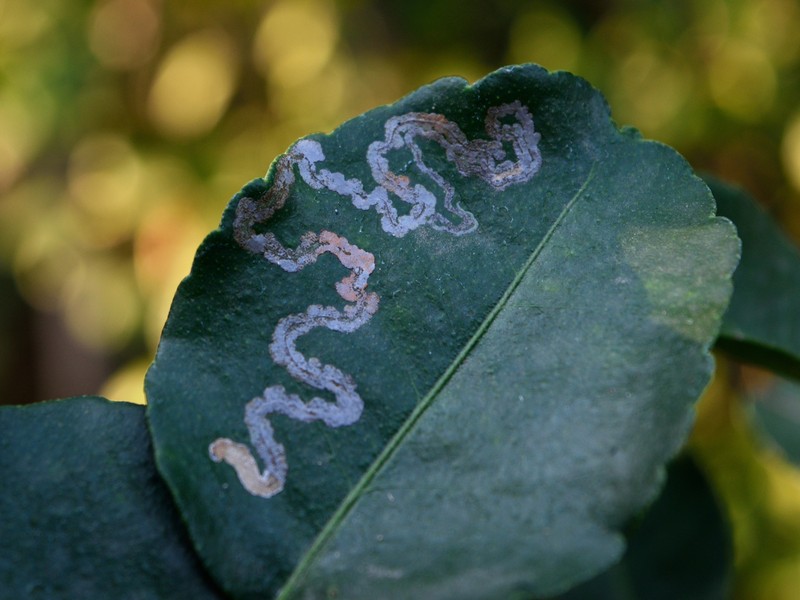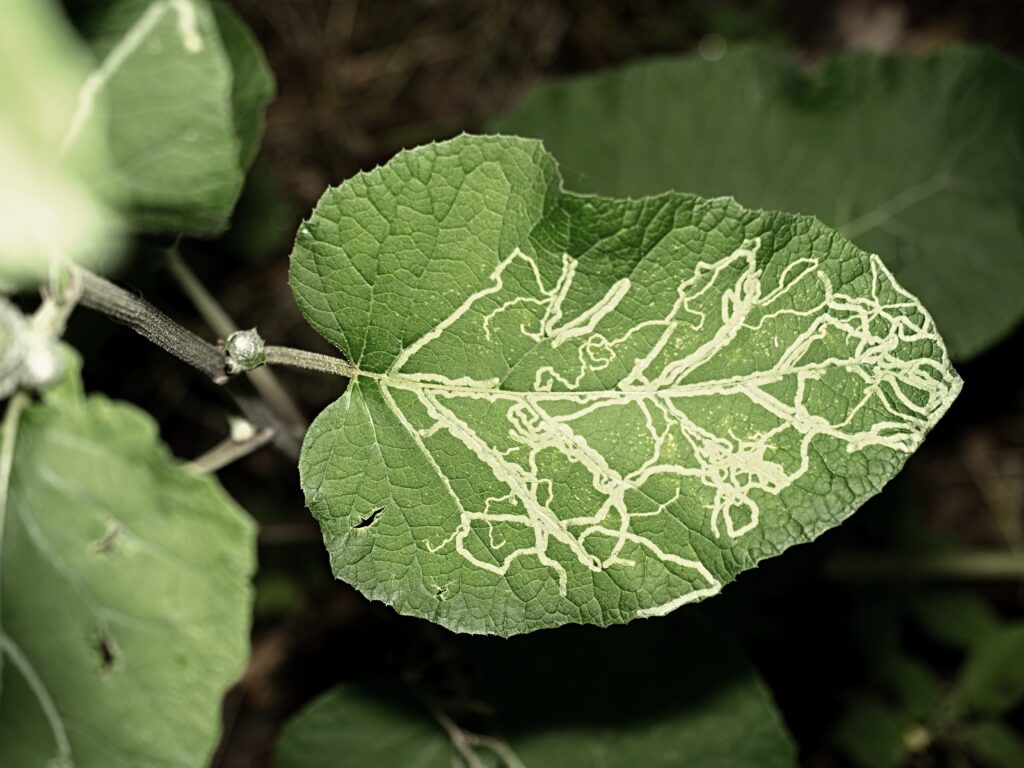Adult leafminers are black-bristled gray or black flies usually with yellow stripes about 1/10-inch long. Larvae leafminers are stubby, green translucent maggots about 1/8- inch long.
Leafminer maggots feed between the upper and lower surfaces of leaves creating tunnels or mines that appear irregular and white or brown on the surface.
Good Products for Pest and Disease Control at Amazon:
- Garden Safe Snail and Slug Bait
- Bonide Sulfur Fungicide
- Monterey BT Caterpillar Killer
- Neem Bliss 100-% Cold Pressed Neem Oil
- Safer Brand Insect Killing Soap
- PyGanic Botanical Insecticide
Leafminer flies emerge from the soil in spring to lay eggs on the undersides of leaves or directly inside leaf tissue. The eggs are white, cylindrical, and laid in clusters.

The tiny maggots emerge and feed their way through the middle of leaves for one to three weeks. When maggots finish feeding they emerge from the leaves and drop to the soil to pupate for two to four weeks. There are several generations of leafminers from spring to late summer.
The damage inflicted by leafminers will not cause plants to die but the damage distracts from the appearance of leaves and may cause plants to lose foliage. Some leaves attacked by leafminers may appear yellow blotched and blistered. Leafminers can carry black leg disease and soft rot diseases.
There are several species of leafminers in North America.
Spinach and beet leafminers are most active in spring when they attack young beets and spinach. By midsummer, a second species, the vegetable leafminer attacks tomatoes and other crops.
Leafminers pass the winter as cocoons in the soil.
Scientific name: Family Agromyzidae
Target plants
Spinach and beet leafminers feed on spinach, beets, and Swiss chard. Vegetable leafminers feed on cabbage, lettuce, peppers, radishes, tomatoes, and turnips. Other leafminers feed on citrus and many ornamental plants.
Feeding habits and damage
Adults feed by sucking on plant tissue. Larvae tunnel within leaves feeding on leaf tissue and making round or winding hollow mines or tunnels. Leafminers can destroy seedlings. On larger vegetables and ornamental shrubs and trees, leafminer damage is more an unsightly nuisance than a serious problem.
Organic controls
Cover seedlings with floating row covers to exclude leafminer flies. Pick and destroy egg clusters and mined leaves. Remove weeds such as dock or lamb’s quarters which are hosts for beet leafminers. Attract native parasitic wasps by planting nectar plants around the garden. Spray with neem as a last resort to kill larvae in their tunnels.

Organic control calendar
Here is what you can do seasonally to control flea leafminers:
- Before planting: Turn the soil to bury leafminer pupae from reaching the soil surface. Remove pigweed, plantain, chickweed, and lamb’s quarters from the garden; these plants harbor leafminer flies and larvae. Plant a trap crop of radishes or weed lambs’ quarters to attract and spot early infestations of leafminers. Remove and destroy leaves and plants as soon as larvae start feeding.
- At planting time: Plant beets and chard much earlier or later than usual to avoid the emergence of leafminer flies. Keep flies from laying eggs on plants by covering seedlings and plants with floating row covers; be sure the edges of the covers are buried to keep flies out. If flies get to the pants, remove and destroy infested leaves before larvae mature.
- While crops develop: Handpick damaged leaves before leafminers move to undamaged leaves. Spray leaves and stems of plants with horticultural oil; oil suffocates leafminer larvae on contact. Handpick and destroy eggs; they will be found on the undersides of leaves. The eggs are chalk white and 1/8 inch long. Flies lay four to five eggs once a week for 3 to 4 weeks. Hatched eggs will look like grayish blisters on the leaves—crush them or scratch them off. Cut tunneled leaves from the plant and destroy them. Cut away badly damaged portions of leaves; the undamaged portions of spinach and other leafy crops you can eat. Remove pigweed, plantain, chickweed, and lamb’s quarters from the garden
- After harvest: Clean the garden of all plant debris; leafminers overwinter in the soil and emerge in the spring. Remove all weeds from the garden especially lamb’s quarters. Plant cold-hardy beets and spinach in the fall; mulch well to overwinter them; the plants will leaf out in spring for harvest before the first generation of leafminers.
Natural predators
Parasitic wasps attack larvae; chickadees, purple finches, and robins eat leafminers.
Related articles:
Vegetable Garden Organic Pest Control
Vegetable Garden Diseases Problem Solver
Vegetable Garden Organic Weed Control
Garden Planning Books at Amazon:
- Vegetable Garden Almanac & Planner
- Kitchen Garden Grower’s Guide Vegetable Encyclopedia
- Vegetable Garden Grower’s Guide
- Tomato Grower’s Answer Book















